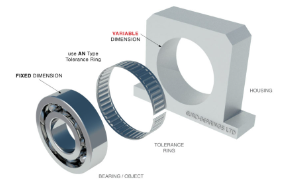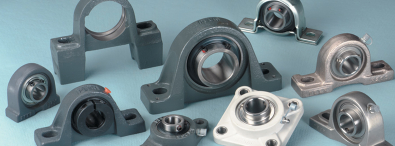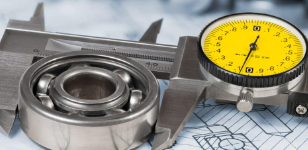The Basics of Bearing Housing Tolerance: What You Need to Know
Learn about bearing housing tolerance and its importance for machine efficiency and longevity.
Understand the types, factors affecting it, common issues, and how to troubleshoot.
In this article, I will discuss the basics of bearing housing tolerance,
why it is essential for machine efficiency and longevity, and what you need to know to maintain it properly.
Did you know that improper tolerance levels can cause noise, vibration, and premature failure of equipment?
Answer Section: Bearing housing tolerance refers to the amount of allowable deviation in the fit between the bearing and the housing.
There are two types of tolerances - radial and axial - that need to be maintained for optimal performance.
Factors that affect tolerance include temperature, lubrication, and load. Improper tolerance levels can lead to issues such as noise, vibration, and premature failure.
Troubleshooting and correction involve checking the tolerance level, lubrication system, and load.
Understanding the importance of bearing housing tolerance is crucial for maximizing the performance and lifespan of your equipment.
Keep reading to learn more about the different types, factors affecting tolerance, common issues, and how to troubleshoot them.
What is bearing housing tolerance?

Bearing housing tolerance is an important aspect of bearing design and maintenance.
It refers to the allowable variation in the size of the bearing housing. Tolerance is critical because it affects the fit and alignment of the bearing,
which is essential to ensure proper performance and prevent damage to the equipment.
Bearing housing tolerances are typically determined based on several factors such as bearing size, operating temperature, speed, load capacity, and material.
Therefore, the tolerance can vary depending on the application and the type of bearing used.
In general, three types of tolerances affect the bearing performance. These include:
1.Clearance Tolerance: This is the amount of space between the bearing and the housing when the bearing is installed.
If the clearance is too tight, it will cause excessive friction, overheating, and premature wear.
Conversely, if the clearance is too loose, it can lead to vibration and noise.
2.Interference Tolerance: This is the amount of overlap between the bearing and the housing when the bearing is installed.
If the interference is too high, it can cause the bearing to deform or crack during installation, leading to premature failure.
If the interference is too low, the bearing may become loose or displaced during operation, causing damage to the machine.
3.Roundness Tolerance: This is the allowable deviation in the roundness of the bearing housing.
If the housing is not round, it will cause uneven bearing wear and affect the alignment of the bearing, leading to premature failure.
Bearing manufacturers typically provide tolerance specifications for their products to ensure proper fit and alignment.
Adhering to these specifications is crucial to prevent damage to the equipment and ensure optimal bearing performance.
Moreover, the use of the correct tolerance can also reduce the risk of maintenance costs and downtime.
It ensures that the bearing and housing are aligned correctly, reducing the risk of damage to the equipment and increasing the bearing's service life.
Proper alignment also ensures that the bearing can operate at its optimal load capacity and speed, reducing the risk of failure.
Bearing housing tolerance is an important consideration in the design and maintenance of equipment that uses bearings.
Adhering to the recommended tolerance specifications by the bearing manufacturer can ensure proper fit,
alignment, and performance of the bearing, reducing the risk of damage to the equipment and increasing uptime.
Types of Bearing Housings

Pillow Block Bearing Housings:
A pillow block housing, also known as a Plummer block, is a pedestal housing that is designed to support a shaft and bearing.
It consists of a base plate, a pedestal, and a mounting surface for the bearing.
The base plate is typically made of cast iron or steel and is bolted to the machine frame.
The pedestal provides support for the shaft and bearing and is designed to reduce vibration and noise.
Pillow block housings are commonly used in conveyor systems, agriculture, and mining equipment.
Flange Bearing Housings:
A flange housing is a flat, circular housing that is designed to support a bearing at one end of a shaft.
It consists of a flange plate and a mounting surface for the bearing.
The flange plate is typically made of cast iron or steel and is bolted to the machine frame.
Flange housings are commonly used in motors, pumps, and other rotating equipment.
Take-up Bearing Housings:
A take-up housing is a type of bearing housing that is used to adjust the tension on a conveyor belt or chain.
It consists of a base plate, a take-up frame, and a mounting surface for the bearing.
The base plate is typically bolted to the machine frame, and the take-up frame can be adjusted to increase or decrease the tension on the conveyor belt or chain.
Take-up housings are commonly used in mining and material handling equipment.
Various types of Bearing Housing tolerances

Bearing housing tolerances are an important consideration in bearing design and maintenance.
They refer to the allowable variation in the size of the bearing housing, and they affect the fit and alignment of the bearing.
In addition to the three types of tolerances that affect bearing performance that was mentioned in the first part of the article,
such as clearance tolerance, interference tolerance, and roundness tolerance.
There are also two main types of bearing housing tolerances, including radial and axial tolerances.
1. Radial Tolerance:
Radial tolerance is the allowable deviation in the size of the bearing housing in the radial direction.
It refers to the amount of space between the bearing and the housing when the bearing is installed.
If the radial tolerance is too tight, it can cause excessive friction, overheating, and premature wear.
On the other hand, if the radial tolerance is too loose, it can lead to vibration and noise.
Therefore, it is essential to select the appropriate radial tolerance based on the bearing size,
operating temperature, speed, load capacity, and material.
2. Axial Tolerance:
Axial tolerance is the allowable deviation in the size of the bearing housing in the axial direction.
It refers to the amount of overlap between the bearing and the housing when the bearing is installed.
If the axial tolerance is too high, it can cause the bearing to deform or crack during installation, leading to premature failure.
On the other hand, if the axial tolerance is too low, the bearing may become loose or displaced during operation, causing damage to the machine.
Therefore, it is critical to select the appropriate axial tolerance based on the bearing size, operating temperature, speed, load capacity, and material.
Factors Affecting Bearing Housing Tolerance
Bearing housing tolerance refers to the allowable variation in the size of the bearing housing, and it affects the fit and alignment of the bearing.
Several factors can affect bearing housing tolerance, including temperature, lubrication, and load.
These factors are critical in bearing performance and can significantly impact bearing service life.
1. Temperature:
Temperature is a critical factor that affects bearing housing tolerance.
High temperatures can cause thermal expansion of the bearing housing, resulting in a decrease in the radial and axial tolerances.
This can lead to insufficient clearance, which causes excessive friction, overheating, and premature wear.
On the other hand, low temperatures can cause thermal contraction of the bearing housing, increasing the radial and axial tolerances.
This can lead to excessive clearance, which causes vibration and noise.
Therefore, it is essential to select the appropriate tolerance based on the expected operating temperature of the bearing.
2. Lubrication:
Lubrication is another critical factor that affects bearing housing tolerance.
Proper lubrication can reduce friction and wear, preventing premature failure of the bearing.
Lubrication also helps maintain the correct radial and axial tolerances by minimizing heat generation and maintaining the proper clearance between the bearing and the housing.
However, insufficient or improper lubrication can lead to increased friction, overheating, and premature wear, causing the bearing to fail.
Therefore, it is essential to select the appropriate lubricant and maintain the recommended lubrication schedule based on the bearing size, speed, load, and operating temperature.
3. Load:
Load is another critical factor that affects bearing housing tolerance.
High loads can cause deformation of the bearing housing, resulting in a decrease in the radial and axial tolerances.
This can lead to insufficient clearance, which causes excessive friction, overheating, and premature wear.
On the other hand, low loads can cause the bearing to become loose, leading to vibration and noise.
Therefore, it is essential to select the appropriate tolerance based on the expected load capacity of the bearing and the application.
In addition to these factors, other factors can affect bearing housing tolerance, such as the material of the housing and the installation method.
It is critical to consider all these factors when selecting the appropriate tolerance for the bearing housing.
By adhering to the recommended tolerance specifications provided by the bearing manufacturer and considering these factors,
the bearing can operate efficiently and with longer service life, reducing the risk of damage to the equipment and increasing uptime.
Common Issues Caused by Improper Bearing Housing Tolerance
Improper bearing housing tolerance can cause several issues that can affect the performance and lifespan of the bearing.
Common issues that can arise from improper bearing housing tolerance include noise, vibration, and premature failure.
Here is an in-depth explanation of these issues and how to troubleshoot and correct them.
1. Noise:
Excessive noise can occur when the bearing housing tolerance is too loose or too tight.
When the tolerance is too loose, the bearing may move around inside the housing, causing the noise.
On the other hand, when the tolerance is too tight, the bearing may rub against the housing,
resulting in noise. To troubleshoot noise issues, you should first determine if the noise is coming from the bearing or another component.
Then, inspect the bearing housing to see if the tolerance is within the recommended specifications.
If it is not, you should adjust the tolerance to the appropriate level or replace the bearing housing altogether.
2. Vibration:
Vibration can occur when the bearing housing tolerance is not appropriate, causing the bearing to move or become unstable.
This can cause damage to the equipment and lead to premature failure.
To troubleshoot vibration issues, you should first determine if the vibration is coming from the bearing or another component.
Then, inspect the bearing housing to see if the tolerance is within the recommended specifications.
If it is not, you should adjust the tolerance to the appropriate level or replace the bearing housing altogether.
3. Premature Failure:
Premature failure can occur when the bearing housing tolerance is not appropriate, causing excessive friction, overheating, and premature wear.
This can result in damage to the bearing and the equipment, leading to costly repairs and downtime.
To troubleshoot premature failure issues, you should first inspect the bearing to determine the cause of the failure.
Then, inspect the bearing housing to see if the tolerance is within the recommended specifications.
If it is not, you should adjust the tolerance to the appropriate level or replace the bearing housing altogether.
To correct issues caused by improper bearing housing tolerance, you should follow these steps:
1.Identify the problem: Determine if the issue is noise, vibration, or premature failure,
and determine if it is coming from the bearing or another component.
2.Inspect the bearing housing:Check if the tolerance is within the recommended specifications.
If it is not, adjust the tolerance to the appropriate level or replace the bearing housing altogether.
3.Check other factors: Check other factors that can affect bearing performance, such as lubrication, temperature, and load.
4.Monitor performance:After correcting the issue,
monitor the bearing's performance to ensure that the issue is resolved and that the bearing is operating within the recommended specifications.
Conclusion
Proper bearing housing tolerance is essential for machine efficiency and longevity.
By maintaining the recommended tolerance levels, you can prevent issues such as noise, vibration,
and premature failure, optimize the lubrication system, and ensure that the bearing operates within its design limits.
This will ultimately increase uptime, reduce the risk of equipment damage, and extend the lifespan of the equipment,
leading to significant cost savings and improved productivity.





